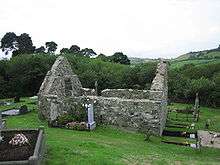Loughinisland Churches
The Loughinisland Churches are the remains of three ruined churches in Loughinisland, County Down, Northern Ireland, dating from the 13th to the 17th centuries. They are situated in Tievenadarragh townland, in a large graveyard on an island in Loughinisland Lake, now reached by a causeway.[1] The churches are state-care historic monuments at grid ref: J4234 4537.[2]

History
The earliest recorded reference is to a parish church on the site in 1306. The Middle Church is the oldest, probably from the 13th century. The large North Church was built in the 15th century, probably to replace the Middle Church, and continued in use until 1720. The smallest is the South (MacCartan's) Church, the elaborately carved west door of which has the date 1636 and initials PMC for Phelim MacCartan. This was probably the main burial ground of the MacCartans who had one of their chief seats near the lake.[1][3]
The North Church was in use until about 1718. Local accounts say that at one time there was an amicable arrangement for the church to be used for both Protestant and Roman Catholic worship, but that a dispute rose one wet Sunday, when Roman Catholics were unwilling to leave the church due to the rain, and free the church up for the Protestants.[4] This displeased the Forde family so much that they dismantled the old church and built a new one in Seaforde which was roofed with the timbers of the old building.[5]
The island and its churches appear in medieval sources under the name Lerkes or Lyrge.[6]
Features
The three churches all lie roughly east and west, but are not strictly parallel. The most ancient church, the Middle Church is 39ft by 23.5ft and its walls are nearly 4ft thick. There is a local tradition that this church was never actually finished.[4] It is rectangular and built of coarse rubble with rough squared quoins. Some gables have fallen and are now standing to an average height of around 10ft. At the south-east angle is a small wall-cupboard.[6]
The North Church is 66.5ft by 30ft, the gables and most of the side walls are standing and a doorway in the west end has a narrow window above it. It is built of coarse split-stone rubble with semi-wrought quoins, with walls of an average thickness of around 3ft. In the south wall are two small cupboards.[6]
The South Church is 27.5ft by 20ft and is probably of earlier date than the 1636 date inscribed on it, appearing to have been previously remodelled. The western doorway (of dressed Castle Espie limestone[5]) supports a semi-circular arch built of two stones, each forming a quadrant.[4] It is rectangular with walls around 3ft thick, built of split-stone rubble with limestone quoins and dressings. The east window has two pointed, chamfered windows, with mullion now removed. Set into the wall above the doorway is a stone effigy of a human head, which probably predates the church. On the floor is a recumbent stone which mentions four prominent members of the McCartan family.[6]
References
- Department of the Environment for Northern Ireland (1983). Historic Monuments of Northern Ireland. Belfast: HMSO. pp. 104–105.
- "Tievenadarragh" (PDF). State Care Historic Monuments. Retrieved 16 July 2009.
- Harbinson, P. (1992). Guide to National and Historic Monuments of Ireland. Dublin: Gill & Macmillan. p. 116.
- Government of Northern Ireland (1947). An Account of the Ancient Monuments in State Charge. Belfast: HMSO. pp. 25–26.
- "The Three Ruined Churches of Loughinisland". Ros Davies' County Down, Northern Ireland Genealogy Research Site. Retrieved 16 July 2009.
- "Loughinisland ancient church site". A Journey through Kinelarty. Archived from the original on 22 March 2011. Retrieved 16 July 2009.
External links
| Wikimedia Commons has media related to Loughinisland Churches. |